#14,473
Although we've already seen 7 cases reported in the first 17 days of October, only 4 MERS infections were reported globally during the month of September, all hailing from Saudi Arabia.
While this reduced MERS activity is welcomed, over the past year new questions have been raised over the ability of current surveillance systems to identify mildly symptomatic, asymptomatic, or atypically presenting MERS infections in the community.
A few of those studies include:
J. Korean Med Sci: Atypical Presentation Of A MERS Case In A Returning Traveler From KuwaitAnd just over a year ago - in Evaluation of a Visual Triage for the Screening of MERS-CoV Patients - we looked at what has been described as a serious flaw in Saudi Arabia's MERS surveillance program.
mBio: High Prevalence of MERS-CoV Infection in Camel Workers in Saudi Arabia
AJIC:Intermittent Positive Testing For MERS-CoV
JIDC: Atypical Presentation Of MERS-CoV In A Lebanese Patient
Once a month the WHO's EMRO (Eastern Mediterranean Regional Office) provides a summary of MERS activity in the Middle East - and around the world - based on what is officially reported by individual Ministries of Health to the World Health Organization.
Details of the September summary report follow:
MERS situation update, September 2019
- At the end of September 2019, a total of 2468 laboratory-confirmed cases of Middle East respiratory syndrome (MERS), including 851 associated deaths (case–fatality rate: 34.4%) were reported globally; the majority of these cases were reported from Saudi Arabia (2077 cases, including 773 related deaths with a case–fatality rate of 37.2%).
- During the month of September, a total of 4 laboratory-confirmed cases of MERS were reported globally. All the 4 cases were reported from Saudi Arabia with 1 associated death. No cluster of cases was reported this month. All of the cases had their symptoms onset in September. The reported cases were between 39 and 74 years of age and all were male. No healthcare workers were affected this month.
- The demographic and epidemiological characteristics of reported cases, when compared during the same corresponding period of 2014 to 2019, do not show any significant difference or change. The number of cases reported in this period was more than 2018, but significantly less than the 2014-2017 corresponding period.
Read the latest MERS update for September 2019
- The age group 50–59 years continues to be at the highest risk for acquiring infection of primary cases. The age group 30–39 years is most at risk for secondary cases. The number of deaths is higher in the age group 50–59 years for primary cases and 70–79 years for secondary cases.
Subscribe to the Infectious Hazard Management monthly e-mail update for the latest data and analysis.

